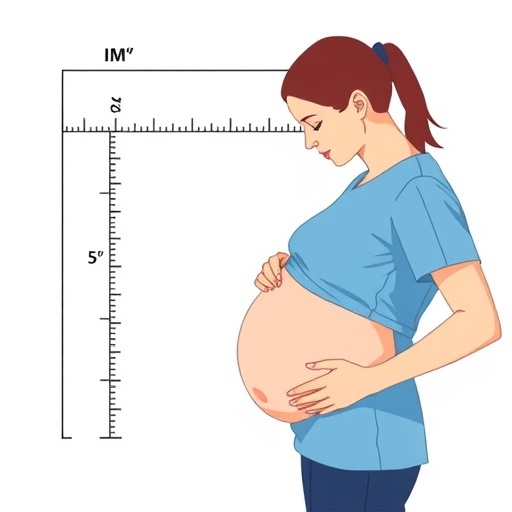In a groundbreaking study conducted within the healthcare framework of Tanzania, researchers have highlighted the critical role of anthropometric measurements in identifying low birth weight among neonates. This research draws attention to the pressing issue of low birth weight, which is known to increase morbidity and mortality rates in newborns. The findings of this investigation, published in the esteemed journal BMC Pediatrics, shed light on how anthropometric measurements can serve as a valid surrogate for traditional weighing methods, thereby enhancing early detection and intervention strategies in clinical settings.
Low birth weight remains a significant public health concern globally. Defined as a birth weight of less than 2,500 grams, low birth weight is often associated with premature births, fetal growth restriction, or a combination of both. Understanding its determinants and improving identification methods is vital. The emerging evidence presented by Salim Abdallah N, Nh., Kija, E., and Naburi, H. (et al.) provides a fresh perspective on how healthcare professionals can better assess and manage this condition.
The researchers conducted their study at a tertiary hospital in Tanzania, where they systematically compared anthropometric measurements—including head circumference, mid-upper arm circumference, and abdominal circumference—with the traditional gold standard of direct weight measurement. Their approach aimed not only to evaluate the efficacy of these measurements but also to address the logistical challenges faced in many resource-limited healthcare settings. This research is particularly relevant in regions where access to weighing scales is limited or where equipment may not be readily available.
During the study, the authors meticulously collected data from a significant number of neonates. The research design embraced a rigorous methodology, ensuring that the sample was representative of the population and that the data synthesized was robust. This meticulous approach allowed for a deeper analysis of the correlation between the anthropometric measures and actual birth weights, leading to compelling results.
The comparative analysis revealed encouraging outcomes. It was found that specific anthropometric measurements could reliably predict low birth weight, demonstrating a strong correlation with the traditional weighing method. This finding is noteworthy, as it suggests that healthcare providers might adopt these simpler measurement techniques in everyday practice without sacrificing diagnostic accuracy. By leveraging such accessible metrics, the potential for early identification of at-risk neonates increases significantly.
Furthermore, the implications of this research extend beyond merely identifying low birth weight. Accurate assessment is crucial in devising appropriate nutritional and medical interventions for neonates. For instance, when healthcare workers can quickly and reliably categorize newborns into weight status categories through anthropometric measurements, they can initiate timely care plans that may include nutritional support and referrals for specialized care if necessary.
Additionally, this study contributes to the ongoing discourse about the role of technology and training in enhancing healthcare delivery in developing countries. Such findings advocate for the integration of anthropometric assessments into standard neonatal care protocols. Continuing education for healthcare professionals in the application of these techniques can empower them and improve overall neonatal outcomes in resource-limited settings.
The socioeconomic factors contributing to low birth weight are also highlighted by this study. These factors often include maternal health, nutritional status, access to prenatal care, and education. Addressing these underlying challenges is equally important in concert with implementing more effective identification methods. Public health initiatives focusing on maternal education can promote healthier behaviors and improve overall neonatal health.
While the findings are promising, the authors caution that the adoption of anthropometric measurements as a sole method for identifying low birth weight should be approached with careful consideration. They emphasize that while these measurements can indeed serve as a useful surrogate, they are not a one-size-fits-all solution. Additional research is still needed to evaluate the efficacy of these measurements across diverse populations and in varying clinical contexts.
In conclusion, the research conducted by Salim Abdallah and colleagues marks a significant contribution to the field of pediatric healthcare, particularly in the context of low birth weight identification. By advocating for the use of anthropometric measurements, they not only offer practical solutions to the challenges faced in neonatal care but also encourage ongoing research and exploration in this critical area. Their findings provide a pathway toward improved neonatal health outcomes, emphasizing the importance of innovative thinking in addressing long-standing public health issues.
As the healthcare community continues to grapple with the implications of low birth weight, this study stands as a beacon of hope and a call to action. It urges healthcare providers, policymakers, and researchers alike to collaborate on creating effective strategies that leverage accessible measures while focusing on the broader determinants of health. The collaborative nature of addressing this issue will ultimately pave the way for healthier futures for newborns across the globe.
The significance of this research extends far beyond the realm of clinical settings. Policymakers and health authorities are encouraged to consider integrating findings from such studies into public health initiatives aimed at reducing the prevalence of low birth weight. Efforts must not only focus on direct healthcare delivery but also on addressing socio-economic and environmental factors that underpin neonatal health.
The journey of this research from conception to publication exemplifies the vital importance of scientific inquiry in advancing our understanding of health challenges and developing innovative solutions to combat them. Though it acknowledges the challenges faced by many healthcare systems, it ultimately inspires confidence in the transformative potential of research-driven initiatives in the pursuit of improved health outcomes for the youngest and most vulnerable members of society.
Subject of Research: Low birth weight identification through anthropometric measurements.
Article Title: Anthropometric measurements as surrogate for identifying low birth weight: comparison with gold standard of measuring weight among neonates at a tertiary hospital in Tanzania.
Article References:
Salim Abdallah N, Nh., Kija, E., Naburi, H. et al. Anthropometric measurements as surrogate for identifying low birth weight: comparison with gold standard of measuring weight among neonates at a tertiary hospital in Tanzania. BMC Pediatr 25, 907 (2025). https://doi.org/10.1186/s12887-025-06228-w
Image Credits: AI Generated
DOI: https://doi.org/10.1186/s12887-025-06228-w
Keywords: Neonate, Low birth weight, Anthropometric measurements, Public health, Maternal health, Pediatric research.




